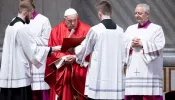When a minister of the Church brings Communion, the sick or elderly person shares in the eucharistic meal of the community. This holy Communion manifests the support and concern of the community for its members who are not able to be present. Holy Communion is a bond to the community for its members who are not able to be present. Holy Communion is a bond to the community, as it is a union with Christ. When the Eucharist is brought to the home, the family should prepare a table with a cloth and a lighted candle. All members of the household may receive Communion with the sick person, according to the usual norms. The following texts are among many that may be chosen from the Rite of Communion of the Sick. A briefcase may be needed to carry the following items:
- White stole (for the priest or deacon)
- Holy water sprinkler
- Ritual, or card with prayers
- Crucifix
- Purificator
One should check with the priest as to what is needed; in some cases (e.g., Communion in a hospital), the requirements differ. The priest usually does not wear a surplice during the trip but does wear a narrow white stole under his suit coat.
Greeting
All make the Sign of the Cross. The minister of Communion speaks the following or a similar greeting:
V. Peace be with this house and with all who live here.
All respond:
R. And with your spirit.
Sprinkling with Holy Water
The Blessed Sacrament is placed on the table. The sick person and all present may be sprinkled with holy water. Before this sprinkling, the minister of Communion says:
V. Let this water call to mind our baptism into Christ, who by his death and resurrection has redeemed us.
Penitential Rite
The minister invites all to join in the penitential rite:
V. My brothers and sisters, let us turn with confidence to the Lord and ask forgiveness for all our sins.
After a brief silence, the penitential rite continues:
R. I confess to almighty God
and to you, my brothers and sisters,
that I have greatly sinned
in my thoughts and in my words,
in what I have done
and in what I have failed to do,
(They strike their breast:) through my fault,
through my fault,
through my most grievous fault;
therefore I ask blessed Mary ever-Virgin,
all the Angels and Saints,
and you, my brothers and sisters,
to pray for me to the Lord our God.
or
V. Lord Jesus, you healed the sick:
Lord, have mercy.
R. Lord, have mercy.
V. Lord Jesus, you forgave sinners:
Christ, have mercy.
R. Christ, have mercy.
V. Lord Jesus, you give us yourself to heal us and to bring us strength:
Lord, have mercy.
R. Lord, have mercy.
Then the minister concludes the penitential rite:
V. May almighty God have mercy on us,
forgive us our sins,
and bring us to everlasting life.
R. Amen.
Reading of the Scripture
Then a selection from the Scriptures is read. An appropriate reading should be selected and prepared by the family or the minister of Communion. The following Scriptures are appropriate but are not intended to limit the choice of a reading.
A reading of the Holy Gospel according to John 6:51
Jesus says: "I am the living bread which has come down from heaven. Anyone who eats this bread will live for ever; and the bread that I shall give is my flesh, for the life of the world."
V. The Gospel of the Lord.
R. Praise to you, Lord Jesus Christ.
or John 15: 5
or 1 John 4:16
Lord's Prayer and Communion
Following a time of silence, all join in prayers of intercession. Then, in preparation for holy Communion, all recite the Lord's Prayer.
V. Now let us pray to God as our Lord Jesus Christ taught us.Our Father, . . .
After this, the minister shows the eucharistic bread to those present, saying:
V. This is the Lamb of God
who takes away the sins of the world.
Happy are those who are called to his supper.
All who are to receive Communion respond:
R. Lord, I am not worthy that you should enter under my roof, but only say the word and my soul shall be healed.
The minister gives Communion saying, "The body of Christ," "The blood of Christ," as appropriate. The sick person answers "Amen." All who wish to do so receive Communion in the usual way. After a time of silence, the minister says the following or another prayer:
V. All-powerful and ever-living God,
may the body and blood of Christ your Son
be for our brother (sister) N.
a lasting remedy for body and soul.
We ask this through Christ our Lord.
R. Amen.
Viaticum
Viaticum is the sacrament of the dying. When the minister has brought holy Communion, the rite may begin with the renewal of the dying person's profession of faith.
Viaticum is then celebrated in the same manner as Communion of the Sick, except that after giving Communion, the minister says:
V. May the Lord Jesus Christ protect you and lead you to eternal life.
R. Amen.
The concluding prayer follows:
V. God of peace,
you offer eternal healing to those who believe in you;
you have refreshed your servant N.
with food and drink from heaven:
lead him (her) safely into the kingdom of light.
We ask this through Christ our Lord.
R. Amen.











